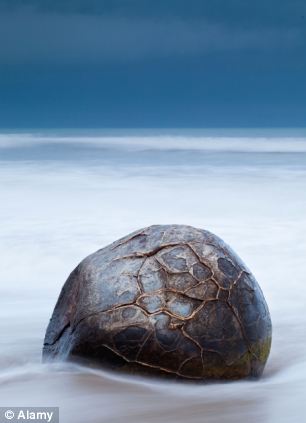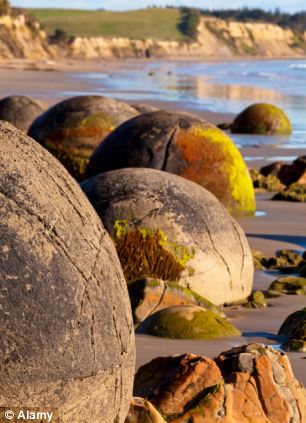|
Giant Stone Balls |
||||||||||||||||||||||
|
New Zealand
Wandering Australia, September 21, 2011
Leaving Timaru very early in sheeting rain we headed
for Oamaru past delightful country side which seemed
to sparkle even in the dismal weather. Past the little
towns of Pareora, St Andrews, Makikihi Waimate and
Glenavy we drove never without the magnificent
scenery. We arrived in Oamaru just as the shops were
opening which enabled us to buy a couple of weather
proof ponchos to keep out the rain (a move that would
prove valuable) and fill up with petrol.
We eventually arrived at the Moeraki Boulders and stopped to experience these unique, perfectly round boulders on the beach made up of rocks wrapped together in Silica and other mineral to form these huge round shapes.
The thing on the right is NOT a boulder - Its ME!
As well
as the boulders, the best examples of this
phenomenon found anywhere in the world, the
beach was strewn with billions of shells of
every kind including Pipis the size of the palm
of my hand. |
||||||||||||||||||||||
|
Moeraki
Boulders
The
Moeraki Boulders at sunrise
The Moeraki Boulders are
unusually large and spherical boulders lying
along a stretch of Koekohe Beach on the wave-cut
Otago coast of New Zealand between Moeraki and
Hampden. They occur scattered either as isolated
or clusters of boulders within a stretch of
beach where they have been protected in a
scientific reserve. The erosion by wave action
of mudstone, comprising local bedrock and
landslides, frequently exposes embedded isolated
boulders. These boulders are grey-colored
septarian concretions, which have been exhumed
from the mudstone enclosing them and
concentrated on the beach by coastal erosion.
Local Māori legends
explained the boulders as the remains of eel
baskets, calabashes, and kumara washed ashore
from the wreck of Arai-te-uru, a large sailing
canoe. This legend tells of the rocky shoals
that extend seaward from Shag Point as being the
petrified hull of this wreck and a nearby rocky
promontory as being the body of the canoe's
captain. In 1848 W.B.D. Mantell sketched the
beach and its boulders, more numerous than now.
The picture is now in the Alexander Turnbull
Library in Wellington. The boulders were
described in 1850 colonial reports and numerous
popular articles since that time. In more recent
times they have become a popular tourist
attraction, often described and pictured in
numerous web pages and tourist guides.
A
cluster of highly spherical boulders
Physical characterThe most striking aspect of the boulders is their
unusually large size and spherical shape, with a
distinct bimodal size distribution. Approximately
one-third of the boulders range in size from about 0.5
to 1.0 metre (1.6 to 3.3 ft) in diameter, the other
two-thirds from 1.5 to 2.2 metres (4.9 to 7.2 ft),
mostly spherical or almost spherical. A small
proportion of them are not spherical; being slightly
elongated parallel to the bedding of the mudstone that
once enclosed them.
Neither the spherical to subspherical shape or large size of the Moeraki Boulders is unique to them. Virtually identical spherical boulders, called "Koutu Boulders", are found on the beaches, in the cliffs, and beneath the surface inland of the shore of Hokianga Harbour, North Island, New Zealand, between Koutu and Kauwhare points. Like the Moeraki Boulders, the almost spherical Koutu Boulders are as large as 3 metres (10 ft) in diameter. Similar boulder-size concretions, known as "Katiki Boulders", are found on the north-facing shore of Shag Point some 19 kilometres (12 mi) south of where the Moeraki Boulders are found. These concretions occur as both spherical cannonball concretions and flat, disk-shaped or oval concretions. Unlike the Moeraki boulders, some of these concretions contain the bones of mosasaurs and plesiosaurs. Large spherical concretions, similar in size and shape to the Moeraki Boulders have been found elsewhere in the world. For example, large spherical concretions as large as 3 metres (10 ft) in diameter are along the Cannonball River within Morton and Sioux Counties, North Dakota. Large spherical concretions as much as 4 to 6 metres (13 to 20 ft) in diameter occur within sandstone outcrops of the Frontier Formation in northeast Utah and central Wyoming. Similar somewhat weathered and eroded giant spheroidal concretions, as large as 6 metres (20 ft) in diameter, are at Rock City in Ottawa County, Kansas. Smaller spherical concretions are found on the shore of Lake Huron near Kettle Point, Ontario, where they are known as "kettles".
A
boulder, showing the hollow interior
Composition
As determined by detailed analysis of the fine-grained
rock using optical mineralogy, X-ray crystallography,
and electron microprobe, the boulders consist of mud,
fine silt and clay, cemented by calcite. The degree of
cementation varies from being relatively weak within
the interior of a boulder to quite hard within its
outside rim. The outside rims of the larger boulders
consist of as much as 10 to 20% calcite, because the
calcite not only tightly cements the silt and clay but
has also replaced it to a significant degree.
The rock comprising the bulk of a boulder is riddled with large cracks called "septaria" that radiate outward from a hollow core lined with scalenohedral calcite crystals. The process or processes that created septaria within Moeraki Boulders, and in other septarian concretions, remain an unresolved matter for which a number of possible explanations have been proposed. These cracks radiate and thin outward from the centre of the typical boulder and are typically filled with an outer (early stage) layer of brown calcite and an inner (late stage) layer of yellow calcite spar, which often, but not always, completely fills the cracks. Rare Moeraki Boulders have a very thin innermost (latest stage) layer of dolomite and quartz covering the yellow calcite spar. The composition of the Moeraki Boulders and the septaria that they contain are typical of, often virtually identical to, septarian concretions that have been found in exposures of sedimentary rocks in New Zealand and elsewhere. Pearson and Nelson (2005, 2006) describe in detail the occurrence of smaller but otherwise very similar septarian concretions within exposures of sedimentary rocks elsewhere in New Zealand. Similar septarian concretions have been found in the Kimmeridge Clay and Oxford Clay of England, and at many other locations worldwide. Origin The Moeraki Boulders are concretions created by
the cementation of the Paleocene mudstone of the
Moeraki Formation, from which they have been exhumed
by coastal erosion.
The main body of the boulders started forming in what was then marine mud, near the surface of the Paleocene sea floor. This is demonstrated by studies of their composition; specifically the magnesium and iron content, and stable isotopes of oxygen and carbon. Their spherical shape indicates that the source of calcium was mass diffusion, as opposed to fluid flow. The larger boulders, 2 metres (6.6 ft) in diameter, are estimated to have taken 4 to 5.5 million years to grow while 10 to 50 metres (33 to 164 ft) of marine mud accumulated on the seafloor above them. After the concretions formed, large cracks known as septaria formed in them. Brown calcite, yellow calcite, and small amounts of dolomite and quartz progressively filled these cracks when a drop in sea level allowed fresh groundwater to flow through the mudstone enclosing them. SOURCE |
||||||||||||||||||||||
Emerging from the cliff, as if being born from the
earth, the World famous Moeraki Boulders are septerian
concretions formed some 65 million years ago.
Crystallization of calcium and carbonates around
charged particles in muddy undersea sediments
gradually formed the boulders in a process taking as
long as four million years.
The soft mudstone containing
the boulders was raised from the sea bed around 15
million years ago and sea erosion of the cliff
is exposing the erosion-resistant boulders.
SOURCE |
||||||||||||||||||||||
Related Links:
References:
|
||||||||||||||||||||||
|
Photo
Gallery
The
spherical boulders began forming in marine mud
(that later became mudstone) of the
Paleocene sea floor, while the cracks, known as septaria formed slightly later
|
||||||||||||||||||||||
| FAIR USE NOTICE: This page contains copyrighted material the use of which has not been specifically authorized by the copyright owner. Pegasus Research Consortium distributes this material without profit to those who have expressed a prior interest in receiving the included information for research and educational purposes. We believe this constitutes a fair use of any such copyrighted material as provided for in 17 U.S.C § 107. If you wish to use copyrighted material from this site for purposes of your own that go beyond fair use, you must obtain permission from the copyright owner. | ||||||||||||||||||||||
|
|





















